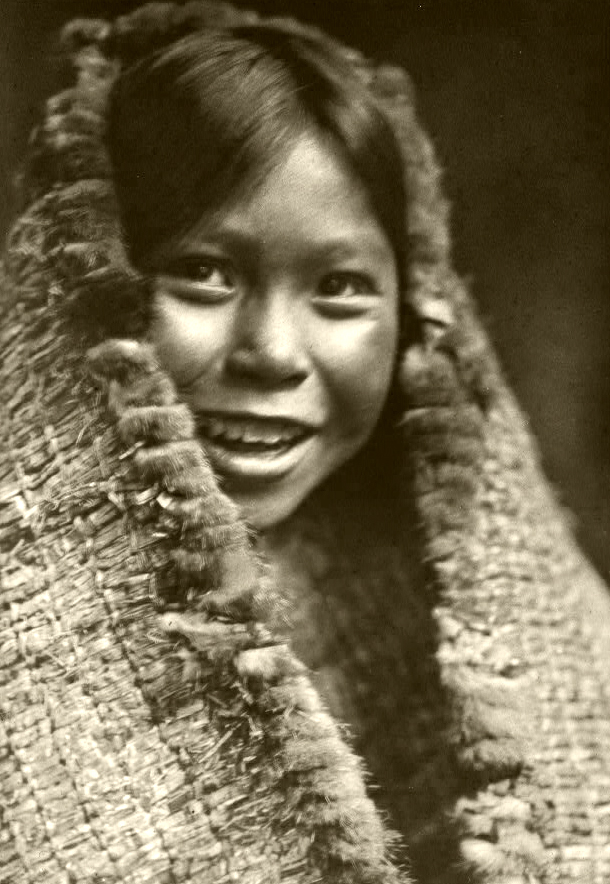The Kyuquot (Ka:’yu:’k’t’h’) and Checleseht (Chek’tles7et’h’) First Nations make up the northernmost Nuu-chah-nulth communities on the west coast of Vancouver Island, British Columbia. Once separate bands, the Kyuquot and Checleseht officially amalgamated in 1962. Both are currently self-governing nations under the Maa-nulth Treaty.
Territory and Population
The Kyuquot and Checleseht nations are found on the west coast of Vancouver Island, British Columbia. Their traditional territory spans the area from the Brooks Peninsula (southern and eastern shores) to Porritt Creek, located north of Nootka Sound. According to the federal government, the two nations have a combined membership of 582 people, 398 of whom live on reserves, as of December 2021.
Traditional Life
The Kyuquot and Checleseht were historically a fishing community. They fished for halibut, salmon, herring, shellfish and other types of saltwater fish off the Pacific coast. The Kyuquot and Checleseht also hunted seals, whales, sea lions and sea otters, and picked berries and vegetation on land to supplement their diet. The First Nations travelled to and from hunting and fishing sites on foot or in dugout cedar canoes.
The Kyuquot and Checleseht were part of a trade network that stretched to the east side of Vancouver Island and possibly further. The Kyuquot and Checleseht First Nations claim that their dentalia shells, which served as currency in Indigenous trading, have been found as far away as Mexico.
Social Organization
The Kyuquot and Checleseht were once separate communities, but they were socially and culturally connected. By the 20th century, the Checleseht had intermarried extensively with the Kyuquot, and by 1950, most Checleseht had settled in Kyuquot villages. In 1962, the Checleseht and Kyuquot officially joined to form one nation, although both retain their separate cultural identities.
The Kyuquot and Checleseht First Nations are confederacies, made up of many chiefly families. They are also self-governing nations, as of 1 April 2011.
Culture
Like other Nuu-chah-nulth nations, the Kyuquot and Checleseht have a strong ceremonial culture, characterised by feasting and entertainment with song, dance, contests and theatricals (see Potlatch).
The Kyuquot and Checleseht are also known for their stunning woodwork, including canoes, totem poles, multifamily houses and other products hand-crafted out of fine cedar, such as baskets (see Northwest Coast Indigenous Art).
Language
The Kyuquot and Checleseht speak Northern Nuu-chah-nulth (Nuu?aan?u?), which is part of the Wakashan language family. The Kyuquot and Checleseht also each speak their own dialects of this language, which are endangered. According to the First Peoples’ Language Map of BC (2012), there were only about 27 people who claimed to speak and understand them fluently. (See also Northwest Coast Language Families; Nuu-chah-nulth: Language).
Religion and Spirituality
The Nuu-chah-nulth belief system centres on a Creator being as well as spirits whose powers can be used to bring peace and fortune. The Nuu-chah-nulth believe that all life forms have a spirit, and should therefore be respected and appreciated. Shamans ensured the spiritual health of the people by practising ancient medicines and healing rituals to cure illness and restore balance to the soul.
Origin Stories
Kyuquot and Checleseht oral tradition tells a tale about the origin of the world in which a being called Thlaathluktiinlth (“Two Hundred Mouths”) descended on the western part of Walters Cove and created the Qwowinasath ? a chiefly family that still exists today. The Qwowinasath occupied Aktis Island, which served as a main village for these early peoples. Kyuquot and Checleseht nations have rich oral histories which also tell stories about the creation of other chiefly families, the environment and the entire earth.
Colonial History
The Nuu-chah-nulth made contact with European explorers and traders in the mid-1700s. The traditional lifestyles of the Kyuquot and Checleseht began to change with prolonged and increased European settlement on their traditional territories. European demand for otter pelts decimated the animal population in that area and pushed Kyuquot and Checleseht peoples out of their wintering villages. Additionally, the establishment of commercial forestry, whaling and fishing industries altered the landscape and the peoples’ way of life. Europeans also brought with them diseases, such as tuberculosis, measles and smallpox, which killed many Kyuquot and Checleseht people. Survivors were increasingly displaced onto reserves and subjected to the Indian Act, residential schools and other federal programs and policies that sought to assimilate Indigenous peoples.
Contemporary Life
The Kyuquot and Checleseht First Nations are part of the Nuu-chah-nulth Tribal Council (previously known as the West Coast Allied Tribes), an association founded in 1958 that provides various services to approximately 9,500 registered members, including child welfare, education, employment training and other socio-economic programs that support health and development.
The Kyuquot and Checleseht First Nations, along with several other Nuu-chah-nulth nations, have signed the Maa-nulth treaty, which has provided them with self-governance since 1 April 2011. Self-governance provides these nations with certain rights regarding citizenship and law making in their traditional territories.

 Share on Facebook
Share on Facebook Share on X
Share on X Share by Email
Share by Email Share on Google Classroom
Share on Google Classroom






